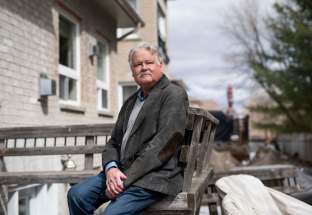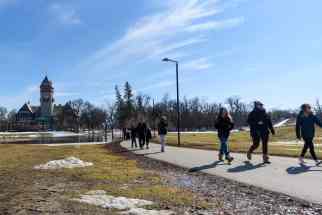Prescription for a pandemic Federal, provincial and municipal public-health officials are working together to get Canadians through the COVID-19 crisis; it's a marked departure from the dysfunctional system that dodged the SARS bullet 17 years ago
Read this article for free:
or
Already have an account? Log in here »
To continue reading, please subscribe:
Monthly Digital Subscription
$19 $0 for the first 4 weeks*
- Enjoy unlimited reading on winnipegfreepress.com
- Read the E-Edition, our digital replica newspaper
- Access News Break, our award-winning app
- Play interactive puzzles
*No charge for 4 weeks then billed as $19 every four weeks (new subscribers and qualified returning subscribers only). Cancel anytime.
Read unlimited articles for free today:
or
Already have an account? Log in here »
Hey there, time traveller!
This article was published 02/04/2020 (1477 days ago), so information in it may no longer be current.
OTTAWA — At the height of the 2003 SARS crisis, Canada’s patchwork public-health system was sputtering along.
Officials tracked infections with sticky notes and there was constant squabbling among jurisdictions.
A lack of coherent data reporting sparked a no-travel edict on Toronto, which left a $1.1-billion economic crater in that city.

Beyond a public-health crisis, it was an administrative disaster.
Fast-forward 17 years; Canadians have seen a nearly seamless collaboration in the way their cities, provinces and Ottawa are responding to the COVID-19 pandemic. It’s the direct result of a frank report that revolutionized public health.
“These are things that we take for granted, but it does take expertise for people to anticipate the problems, and not just react to them,” said David Butler-Jones, who was Canada’s first chief public health officer.
Creating that role was among the recommendations of the federally commissioned report Learning from SARS, by prominent physician David Naylor.
Following those recommendations has given officials clarity on how to communicate with the public, sort out responsibilities and make ethical decisions.
Yet funding gaps and inconsistent data could prevent the country’s leaders from avoiding some of the mistakes flagged in the 2003 report. Butler-Jones witnessed some of those same issues during the H1N1 swine-flu outbreak in 2009.
“I think this will be, again, another reminder,” said Butler-Jones.
The confusion during SARS
Like the current COVID-19 pandemic, SARS was a coronavirus linked to bats that surfaced in China. It emerged in November 2002 and took hold in Toronto three months later.
“If you hadn’t lived through SARS, you probably wouldn’t be aware of how massive a change there has been.” – Sen. Tony Dean
The airborne disease infected numerous medical staff, prompting Ontario to shut down a major hospital.
Sen. Tony Dean oversaw Ontario’s public service over the course of the outbreak. He said bureaucrats weren’t sure how responsibilities were delineated, while medical staff lacked protocols to prevent catching and spreading airborne infections. Officials gave the public mixed messages on how to stay safe, while 11 different organizations offered advice — often conflicting — to front-line doctors.
“We were using coloured stickies on a whiteboard to try to track cases. We didn’t have good surveillance,” Dean said.
Back in 1997, the Krever Inquiry into tainted blood donations had called for central data monitoring on infectious diseases.
Yet during SARS, hospitals initially didn’t share data with each other, and even units within the same building weren’t aware of how many cases they had.
Similarly, Toronto officials withheld data from the province, while Ottawa only stepped in months into the crisis.
“If you had a dispute it became rather public about who was in charge,” Dean recalled.
“It was way less than an optimal experience.”

The virus had little presence outside Toronto hospitals. But because Ottawa couldn’t provide United Nations officials with clear data on the location and intensity of the risk, the World Health Organization issued a travel advisory to avoid visiting Toronto.
The WHO repealed that notice a week later, though many countries kept similar warnings in place for months, devastating the local tourism sector.
The outbreak killed 44 people in and around Toronto, and placed 25,000 residents into quarantine. The Ontario government pegged the cost of the crisis at $1.1 billion. Health-care workers accounted for an estimated 40 per cent of the cases.
“I saw the system struggle to respond to SARS, and I saw heroes step forward from the health system and contain it,” Dean said.
“If you hadn’t lived through SARS, you probably wouldn’t be aware of how massive a change there has been.”
A fire-department model
Naylor’s 2003 report set out 77 recommendations after SARS, emphasizing co-operation.
“The single largest impediment to dealing successfully with future public-health crises is the lack of a collaborative framework and ethos among different levels of government,” read the report.
“SARS really galvanized public opinion behind paying attention to if we’ve got the right distribution of resources in the health system, around prevention and promotion, through to treatment and rehabilitation.” – University of Saskatchewan epidemiology professor Cory Neudorf
“Had the SARS outbreak mushroomed into a truly national epidemic, our lack of preparedness could have been disastrous.”
Naylor envisioned Canada’s public-health units functioning much like a fire department; a nurse or doctor who encounters an unusual case or cluster of disease should notify local public-health officials, who assess whether a higher level of support is required.
“We expect that firefighters and fire engines from different jurisdictions will come together seamlessly to contain an emergency. In the public-health field, this seamlessness can only come about from effective preparedness and co-ordination,” reads the report.
Just as Canada has harmonized fire codes and operating procedures, Naylor said, public-health officials should have similar protocols and know-how to use each other’s equipment before emergencies occur.
Fire department personnel are available to help train the public on how to use fire extinguishers and safely escape from a blaze; Naylor suggested public-health units should similarly have a sufficient number of people to promote healthy living while being able to snap into action during an epidemic.
Ideally, governments would fund public health adequately to pull staff from secondary duties without affecting core responsibilities, such as vaccination programs.
“One of the challenges in emergencies is that you have to have capacity to pay attention to the everyday things because, in a way, that becomes a new emergency,” said Butler-Jones, who served as Canada’s top doctor from 2004 to 2014.
He led the Public Health Agency of Canada from its creation. Following a key recommendation from the Naylor report, Ottawa carved off a branch of Health Canada, where the focus remains on regulation.

Based in both Winnipeg and Ottawa, Butler-Jones oversaw PHAC’s efforts to build up provincial and co-ordinate public-health systems.
That ranged from helping train front-line hospital staff to avoid spreading infections, to operating a world-class research facility.
The National Microbiology Lab in Winnipeg had been open since 1999 with an original focus on supporting and verifying provincial infection tests, deploying to major domestic events to test for threats such as anthrax and researching public-health matters such as tuberculosis in Indigenous communities.
But the lab evolved to conduct groundbreaking research on some of the world’s deadliest diseases. That gives Canada a cadre of experts that can shift to domestic needs when threats and epidemics emerge.
COVID-19 first appeared in Canada in mid-January, at which point NML was confirming all tests done by provincial labs. Two months later, NML staff had certified labs in four provinces, so they can run their own confirmatory tests and report them centrally, instead of shipping hundreds of samples to Winnipeg.
Butler-Jones’ successor, Gregory Taylor, said NML had a much stronger role in helping provinces than its predecessor, the Ottawa-based Laboratory Centre for Disease Control, where he worked for decades.
“It didn’t have the same presence or connections, or visibility that the Naylor report pushed,” said Taylor, who was the nation’s top doctor from 2014 to 2016.
To him, the report’s most powerful result was having a committee of federal and provincial officials regularly touch base. That replaced overlapping agreements and piecemeal committees, allowing ministers and senior bureaucrats to stay on top of trends and co-ordinate everything from annual flu vaccines to data collection.
“Most citizens have done their bit brilliantly, and they deserve nothing less than radical transparency,” physician David Naylor co-wrote in an opinion piece last weekend, calling for anonymized data to be shared in real time, to give “a clearer picture of where we are, and what lies ahead.”
Taylor believes the current coronavirus response is nearly uniform, with the main disparities surrounding when provinces have ordered schools closed or the maximum number of people allowed at public gatherings.
“Everyone across the country is basically on the same page,” Taylor said.
Unclear budgets
Despite the organizational co-ordination borne from the Naylor report, many suspect the fire-department model has never been funded sufficiently to actually work.
The Naylor report suggested Ottawa spend $700 million per year on public health — in 2003, that amounted to three business days of expenditure in Canada’s hospitals and clinics.
It’s difficult to tell how much Ottawa spends on public health, though PHAC’s budget has stayed stable at just under the recommended $700 million for years, despite inflation.
All provinces claim to have ramped up their spending on public-health initiatives over the past two decades, according to data they report, adjusted for population and inflation.
Yet that data isn’t consistent, with provinces lumping everything from addictions classes to occupational health together, said University of Saskatchewan epidemiology professor Cory Neudorf.

“SARS really galvanized public opinion behind paying attention to if we’ve got the right distribution of resources in the health system, around prevention and promotion, through to treatment and rehabilitation,” he said.
“Some of that has started to erode over the past number of years.”
In 2009, hospitals responded to the H1N1 swine flu, but public-health experts later testified on Parliament Hill that the health system nearly collapsed, while hospitals postponed vital surgeries.
A year after that pandemic, provincial governments unanimously agreed that they had to do more to fund public health.
“Canada’s current health system is mainly focused on diagnosis, treatment and care,” reads a 2010 declaration by all health ministers in Canada.
“To sustain our publicly funded health system, a better balance between prevention and treatment must be achieved.”
But many jurisdictions have since cut back.
New Brunswick splintered its public-health unit in 2017, shifting staff into numerous departments.

In 2015, Quebec cut the budgets of all its public-health units by a third, claiming they were largely focused on red tape.
The Ontario government outlined a similar cutback last spring, but scaled back public-health cuts amid protests. Still, that province’s acute shortage of masks, gowns and gloves has raised questions around how existing budgets were allocated.
Similarly, the Naylor report focused on the need for public-health staff to be full-time employees, instead of splitting duties to deal with immediate medical needs, so that there was surge capacity in the system to respond to crises.
Yet most jurisdictions report public-health employees by the equivalent hours, making it hard to track whether provinces are heeding that advice.
“You can’t just go out and find these people,” said Butler-Jones. “There’s only so many with the kind of expertise you need, and you need to have them available.”
He’s also concerned about public health being under the control of public servants.
After Butler-Jones stepped down, the Harper government split the role of chief public health officer from also being the administrative head of PHAC, the deputy minister, in 2014.
The Conservatives said this would let the top doctor focus on medicine, but advocates say the move, repeated at provincial levels, has stripped medical officers of their independence.
Before that shift, top doctors were like auditors general and ombudsmen, administering their own budgets, research priorities and communications.

They’d be held accountable for outcomes in disease prevention and expected to speak out against policies when they felt the elected government of the day was moving in the wrong direction.
For example, Butler-Jones disagreed with the Harper government’s opposition to supervised-injection sites and publicly disputed the closure of a PHAC pilot project that offered tattoos to prisoners, who instead relied on practitioners’ risky methods behind bars, often with unsterilized needles.
Similarly, Butler-Jones recalls leveraging his role as deputy minister to phone senior provincial bureaucrats or even counterparts in other countries, to informally check in on disease trends and prepare responses without bureaucrats adding formalities and delay.
“It was established as a dual role for a reason, and it’s just unfortunate that it’s not anymore,” he said.
Without that independence, Butler-Jones said costly hospitals dominate health care.
As Saskatchewan’s top doctor in the late 1990s, he pushed that province’s government to pay $500,000 for pneumococcal vaccines for seniors, because the Health Department was paying significantly more each year to treat elderly pneumonia patients. He eventually made his case, but he said it illustrates the short-term thinking that drives up expenditures.
“In a public-health budget, half a million dollars is a lot of money, but in an institutional budget, $1 million isn’t anything; it’s hardly a rounding error,” he said.
Taylor, meanwhile, found PHAC’s mandate at times constrained. When the agency was created, Health Canada was kept in charge of tobacco control as it was seen as a regulatory issue, even though it has huge public-health implications.

Similarly, Health Canada controls and updates the Canada Food Guide, which sets baseline nutritional information followed by prisons and social-service agencies.
Balancing transparency
SARS has changed how governments talk with each other, and with the public.
Daily press conferences on COVID-19 have been staggered, so that provincial health officers speak after the prime minister does.
Butler-Jones said there’s a constant balancing act officials perform: keeping the public informed to retain their trust and vigilance, but not leading them to panic over theoretical outcomes.
“Public health really depends on transparency, and the more people know — respecting confidentiality, etc. — in general, the better,” he said.
In 2009, the H1N1 swine-flu pandemic was much less severe than COVID-19. Yet Manitoba’s formal assessment found that provinces and federal officials sent mixed messages on who should wear masks, and Indigenous people were skeptical about the safety of an expedited vaccine targeted at their population.
Butler-Jones recalls trying to correct that confusion by talking with his provincial counterparts about how much information to make public.

“While nobody was told what to say, we would discuss what the implications were of the information,” he said.
Earlier this month, former Manitoba top doctor Joel Kettner suggested the government should be more precise about the risks the province faces and how the current strategies aim to change those outcomes. Premier Brian Pallister was evasive about whether officials have given him a worst-case scenario.
Similarly, the province has avoided for the most part identifying where infected people have worked or spent time. Some experts say divulging too much information will discourage sick people from getting tested.
Ethical guidance
COVID-19 is raising many of the same ethical dilemmas officials faced during the SARS outbreak, which spawned a body to help think about those issues.
The Naylor report identified five ethical dilemmas:
- Civil liberties and restricting movement.
- Personal privacy and the amount of patients’ personal information made public.
- Balancing nurses’ obligations to provide care while also not transmitting disease.
- Denying hospital procedures to those with issues unrelated to SARS.
- The duty to support countries with weaker health systems, which often cause spread to other countries.
The report recommended Ottawa form an ethics working group, to advise the top doctor.
PHAC formed a committee of ethicists from across Canada, whom Taylor said helped him figure out with whom Canada should share the experimental Ebola vaccine created in Winnipeg, and when it was worth the risk of deploying researchers to hard-hit regions of West Africa

“How do you balance the potential harm versus good, when you have a limited resource, and who do you decide who to give it to?” Taylor recalled. “It was very helpful to have this committee.”
That committee is likely helping chief public health officer Dr. Theresa Tam advise the government on balancing civil liberties and how much patient information should be disclosed.
A regularly meeting ethics body was among the items on an internal checklist PHAC officials kept of recommendations from the Naylor report, which was still being used a decade after its release.
“It really was an interesting game-changer,” Taylor said.
Data blind spots
The most glaring shortcoming from the Naylor report in Canada’s COVID-19 response surrounds data collection.
The report noted that in 2003, there wasn’t a central body to accumulate and analyze SARS cases.
PHAC now compiles COVID-19 data, though provinces are providing the agency a patchwork of information. Some report only confirmed cases, while other provinces also report their presumptive cases — some lump both together.

Naylor said on Twitter that Alberta is the only jurisdiction publishing aggregate data on demographics such as sex and age, the growth rate from the date patients first experienced symptoms and the cities in which they’re clustered.
Manitoba, for example, publishes only a breakdown of presumptive and confirmed cases by region, while individual press releases sometimes provide demographic information.
A week ago, Tam falsely stated that 30 per cent of COVID-19 hospitalizations involved people under the age of 40. Data on PHAC’s website at showed the number would instead be 11 per cent, and the agency clarified to the Globe and Mail that the number is actually 12 per cent.
And even though PHAC reports all provinces’ data to the WHO, province still aren’t reporting things such as whether those with coronavirus were hospitalized; as of Tuesday that fact was known in just 60 per cent of cases.
Butler-Jones is concerned by the inability to compare provinces’ caseloads and outcomes, saying it reduces the point of the current daily reporting.
“It’s more important to be consistent than it is to be up-to-the-minute,” he said.
Federal Health Minister Patty Hajdu said she’s asked provinces to beef up their data reporting.
“We have offered resources to provinces and territories, as well, should there be a human-resource challenge, in terms of getting that data to us quickly,” Hajdu told the Free Press on March 23.

Those measures — giving training, support and even cash to provinces to improve their data collection — fall squarely in line with how the Naylor report suggested PHAC be structured.
Similarly, a federal stockpile and bulk-buy program is being used to order millions of masks and gowns and hundreds of ventilators at a lower rate for provinces.
However, officials remain vague on the criteria they use to prioritize provinces’ requests.
Naylor wants governments to step up that purchasing, and beef up public data reporting.
“Most citizens have done their bit brilliantly, and they deserve nothing less than radical transparency,” he co-wrote in an opinion piece last weekend, calling for anonymized data to be shared in real time, to give “a clearer picture of where we are, and what lies ahead.”
Naylor is otherwise tight-lipped about his report, declining multiple interview requests about whether officials have heeded his advice in the past 17 years.
He said Ottawa put many of his recommendations into force, while sometimes opting to tackle the problems he raised through different means.
“There were items that did not seem to get much traction, but that’s par for the course. Policy-makers are in the business of making hard choices about how to spend public resources,” Naylor wrote in an email.

“I expect there will be a fresh review when this outbreak recedes, and an accounting of what went well and what did not. That would be a good time to see if policy-makers were wrong in choosing to overlook some of the 2003 recommendations, as well as to update and improve on the ideas and recommendations we put forward back then.”
Regardless, Dean says the Naylor report has helped officials across Canada respond to COVID-19 with competence he wishes Ontario held in 2003.
“What Canadians are seeing is a system that was revamped, that was strengthened post-SARS and likely post-H1N1, and is being tested now, in the strongest possible way. And it’s doing pretty well in standing up to the test,” he said.
“And this is about as big of a test run we could have.”
dylan.robertson@freepress.mb.ca
2003 Naylor report - Learning from SARS
History
Updated on Saturday, April 4, 2020 9:57 AM CDT: Formatting.








